 Your new post is loading...
 Your new post is loading...
A new survey from Dutch company ING found that 45 percent of international journalists “publish as soon as possible and correct later,” while only 20 percent always do their due diligence before publishing.
Additionally, the 2014 Study Impact of Social Media on News report, created for PR professionals and journalists, reported that one-third of journalists don’t consider social media posts a reliable source of information. Still, 50 percent said the majority of their news tips and facts come from social.
But journalists don’t seem to mind questions of accuracy too much, since 60 percent said they feel less restricted by journalistic standards in their social media reporting. Twenty-two percent reported that they treat social media posts the same way as traditional methods when it comes to journalism ethics....
The New York Times is a 150 years old. So you don't expect it to be a content marketing pioneer. Here are lessons from a leaked report that may surprise you.
...The revelations from the recently leaked report into their challenges of facing upstarts and competitors is a compelling insight into publishing and also content marketing.
Content is the weapon of choice to gain attention traffic and advertising revenue in a digital world.
Content marketing lessons
One observation from the report that surprised me away was that they didn’t use social media for marketing but for measuring!
Here are some insights into how companies need to adapt in a digital age with publishing and content marketing. I have also included actual excerpts from the report....
We don’t typically write about intra-newsroom politics at Nieman Lab, leaving that to Manhattan’s very capable cadre of media reporters. But Abramson’s removal and Dean Baquet’s ascent has apparently inspired someone inside the Times to leak one of the most remarkable documents I’ve seen in my years running the Lab, to Myles Tanzer at BuzzFeed.
It’s the full report of the newsroom innovation team that was given six full months to ask big questions about the Times’ digital strategy. (A summary version of it was leaked last week, but this is the big kahuna.)
There are those who proclaim the rise of digital media is finally giving way to a “golden age of journalism.” And then there are the pessimists who see little but doom or gloom.
And, to be fair, there’s ample evidence for each view. Just check out the Pew Research Center’s 11th annual State of the News Media report that’s being issued today. This year’s study goes in-depth into the revenue picture for news, the rise of digital reporting and growth of digital video. In many ways, this is the best of times and the worst of times for the industry.
You can read the full report at the Pew website or check out a few handy charts here. Meanwhile here’s the speed-read version....
Pew's annual omnibus report finds that the transition to digital, and the influx of new money and new ideas, only represents a sliver of activity in the broader media.
In Pew Research Center’s latest State of the News Media report, just out, you get a glimpse of how the worlds of journalism and technology are continuing to merge and the impact that convergence has on the business and editorial prospects of media companies.
A majority of Americans now say they get news through a digital platform: 82 percent reported using a desktop or laptop, while 54 percent got news through mobile devices, according to Pew. Half of social media users share or repost news stories, while 46 percent discuss news on those sites. Audiences are also spending more time watching their screens: 63 percent of U.S. adults now watch online video, and of that, 36 percent watch news video.
At the same time, the companies that are helping to redefine digital news are expanding aggressively: Pew estimates that digital news operations, from the small hyperlocal shops up to the likes of ProPublica, The Huffington Post, and Vice have produced almost 5,000 full-time editorial jobs. Not enough to make up for a decade of losses in newspapers, but significant....
The Guardian had another big year of digital business last year, further brightening the paper’s long-term outlook. The paper says its digital revenue will hit $117 million in its current fiscal year, which ends on March 31. That’s up a quarter from $92 million the year before. That’s an excellent performance. Even better, the paper says its overall revenue, including print, will be up more than 5 percent from last year, which would put it at about $345 million. In the newspaper world, that’s what counts as torrid growth. It helps that print, which still accounts for two-thirds of Guardian revenue, was down less than 4 percent, according to my estimates....
Journalists have to simplify material for a general audience. Is there a technological fix?Scientists and the journalists who cover them are locked in an “eternal tug of war,” Sabine Hossenfelder writes. The journos feel they have to elide detail so a general audience can read them. The scientists feel the resulting “knowledge transfer” to readers is pitifully low. Hossenfelder illustrates the problem with a series of graphs, like this one...
Caroline Little, CEO CEO of the Newspaper Association of America (NAA), says despite what cynics say, the future of newspapers is bright. In an article published Friday, she shared some NAA research:
"Our audience has grown with the shifting digital landscape, and we’re seeing increased levels of audience engagement and new avenues of consumption. We made the first gain in circulation revenue since 2003, with revenue rising by 5 percent — from $10 billion to $10.5 billion — as digital subscriptions grew dramatically.
The number of unique visitors engaged with U.S. newspaper digital content hit a new high in September 2013, totaling 141 million adults — an impressive increase of 11 percent since just June. We’ve changed with the times to fit the needs of our audience, from print to website to tablet to mobile, adapting our content and strategies for delivery. And it’s working. Across all digital platforms, 71 percent of adults in this country engage with newspaper content, and 55 percent of those visitors consume newspaper content on mobile devices"....
...I should end the year on an upbeat note, shouldn’t I? But Time Inc. ruined it. The surrender of journalism to advertizing and public relations – not alliance with, but surrender to – was the biggest media story of 2013 that the media almost didn’t cover at all. But it’s right there in black and white, if buried on the slowest news day of the year:
Time Inc. will abandon the traditional separation between its newsroom and business sides, a move that has caused angst among its journalists. Now, the newsroom staffs at Time Inc.’s magazines will report to the business executives. Such a structure, once verboten at journalistic institutions, is seen as necessary to create revenue opportunities and stem the tide of declining subscription and advertising sales...
TAKEAWAY: Guess what? Those millennials don’t read news much more differently than their parents and grandparents—-except they almost exclusively read it on a mobile device.
When we at HuffPost Media started talking about what 2013 was like in the media world, we kept coming back to one word: "insane." It's a sentiment that's almost always hyperbolic, but, in this case, we're sticking with it....
If the DOJ's operations showed how dangerous the White House apparently considered journalists to be, the publication of the Edward Snowden leaks by the Guardian, the Post, the Times and other outlets around the world—including, in one instance, The Huffington Post—provided a perfect example of why. People searching for a better case for the impact journalism can have would be hard-pressed to find one.
The revelations sparked international outcry and debate, turned journalist Glenn Greenwald into a global celebrity, and led to an eye-poppingly brutal response from the British government.The UK's hostility towards the Guardian was breathtaking, even to Americans who had just recently been condemning their own government's excesses. Prime Minister David Cameron's government dispatched civil servants to the paper's offices, where editors were told in no uncertain terms that they could either destroy the hard drives containing the Snowden documents or face crippling legal action. (The paper complied, since it had copies in other countries.)...
The State of the Digital News Publishing Industry, According to the InternetThere must be something in the air, maybe the end of a crazy year, that’s making writers introspective. In the past week alone, there have been some very good analyses of the state of the digital publishing . Since it’s cold outside (unless you live in a place where it’s not cold outside, and in that case, stop gloating) and you need some good reads for hibernation, here are five pieces that, I think, aptly explain the industry right now and help further the conversation....
Why are newspaper opinion columnists so consistently baffled by the politics, technologies, and social mores of the 21st century? We've crunched some data, and we think we've figured out the answer: They're old as hell.
|
Stop the presses! For six days a week! Yes, I m being serious. ... I’m going to share a “strategic foresight” (also called “future studies”) exercise with you: a “Futures Wheel” that I created which examines how a particular change might play out. In this case, the hypothetical change is for the New York Times to at some point in the near future stop printing and delivering daily printed newspapers (but retain its Sunday print edition) and focus most of its resources on digital products and services.
Here’s the futures wheel for the no-more-daily-print-edition New York Times. Start at the middle (black box, the proposed change) and go out in spokes to see the various first- and second-level consequences that this change likely will have. Green indicates positive elements likely to gain revenue; red indicates where revenue and/or jobs are likely to be lost. Let’s discuss it after you’ve had a chance to look over it. (Also know that a “futures wheel” is one of many tools in the foresight professional/futurist’s bag. It’s useful in this case to think through the consequences of a significant organizational change.)...
The New York Times Innovation Report has been ripped to pieces by many brains in the media world but the issues are the familiar TBD framework I work with, namely Technology (can/does it do what is needed?), Behaviour (will people do what we need/want?) and Data (will enough people do what we need?).
After ploughing through it, despite a slightly depressing overtone, I am confident the New York Times will pull through…the industry can’t afford it not to (read: have an R&D budget). The very fact it is doing a report of this sort (especially considering who asked for it) means they are focusing and clear about their future problems – success therefore is predicated on hard decisions being made about some very core issues (staff etc).
A few things stood out when I read the report...
A 96-page internal New York Times report, sent to top executives last month by a committee led by the publisher’s son and obtained by BuzzFeed, paints a dark picture of a newsroom struggling more dramatically than is immediately visible to adjust to the digital world, a newsroom that is hampered primarily by its own storied culture.
The Times report was finalized March 24 by a committee of digitally oriented staffers led by reporter A.G. Sulzberger. His father, Times Publisher Arthur Sulzberger, fired Executive Editor Jill Abramson Tuesday, a decision that doesn’t appear immediately related to the paper’s digital weaknesses.
The report largely ignores legacy competitors and focuses on the new wave of digital companies, including First Look Media, Vox, Huffington Post, Business Insider, and BuzzFeed....
The Pew Research Center’s Journalism Project has released its 11th State of the News Media report. A comprehensive “document,” it covers TV, newspapers, magazines, radio and digital.
I won’t try to summarize the full sweep of this “best of times, worst of times” report. However, below I’ve excerpted a few key findings and charts that provide a snapshot into where things stand in US journalism and news consumption....
Last month, venture capitalist Marc Andreessen posted what, in his view, was the future of the news business. Reactions were varied, but everyone had one. I joked that my entire Twitter stream was people replying to Andreessen as he has very publicly thrown himself into the future of news conversation.
We need new voices in this discussion like Andreessen, but his post was too… nice. I’d bet he left his more candid insights out. After the post, I found myself wishing someone would share more actionable observations from the industry.
So, here’s my take. Each one of these could be their own essay. Please argue with me....
… We began our New York meeting by trying to understand why media companies have largely failed to take advantage of the incredible power of the Web and mobile devices.
We identified four forces that have stymied innovation: 1. Content Management Systems. They are designed to convert old media into new media and they provide little flexibility to experiment with new journalistic forms. 2. Newsroom culture. The rhythm in most newsrooms is based on a well-established work flow that produces predictable content. It’s not easy to suggest a wholesale change. 3. Product managers on the business side. They’re accustomed to selling the old recipe and often seem perplexed by new approaches. 4. Editors/news directors. They’ve got other priorities — such as having to choose people for another round of layoffs — and often don’t have the resources for a new venture....
Industry experts from the BBC, CNN, ITV News, Trinity Mirror and The Washington Post share their predictions for the key trends in digital journalism this year.We asked five industry experts from local, national and international news outlets to share their predictions for digital journalism in 2014.
The 10 key trends they identified include short-form video, private social media, drone journalism, responsive design and new apps and devices...
I love the NYT, it has always been one of my favorite publications I've read daily since I was a kid. However this opinion piece on marijuana reform is without question the single worst thing I think I've ever read on the site.
...Clearly many of these people are out of touch with our culture. Opinions of those stuck in their ways, afraid of change and in no way reflecting reality. But it isn’t just age. You can be old and informed on issues and present a balanced opinion.
This is another reason many bloggers have risen so quickly: their words resonate with what’s actually going on. If you have opinions, it’s still a huge opportunity for you to balance those from an alarmist, afraid, homophobic, intolerant and increasingly irrelevant era.
Newspapers are dying. But their front pages aren’t.At a time when print advertising revenue continues to decline and publications are laying off staff in droves, newspaper covers are increasingly being shared digitally — helped along by the ease of posting on Twitter, Facebook and other social media platforms.But why? More than anything, these A1s are seen as an encapsulation of a historical event, to be seen and filed away for a distant time when we want to remember how much something mattered in its day...
A lot of fake things happened this year. A girl twerked upside down, wiped out, and caught on fire. This was not real. A reality TV show producer and a woman were insufferable to one another...
... But as journalists, should we really be going after “Truth” in the vague, poetic Keatsian sense of the word? Or should we be going after “facts”? This is the trap Mike Daisey fell into when it was revealed that his “Agony and Ecstasy of Steve Jobs” monologue, which was packaged as journalism by This American Life, was full of fabrications. Daisey wanted to capture the Truth. Facts were beside the point.What about the hard right-winger whose idea of Truth is that God controls the weather so we should do nothing to combat climate change? What about literal Truthers on the left who, despite having no facts to back it up, can weave a pseudo-compelling narrative that 9/11 was an inside job?...
With all the talk of newspapers as dinosaurs, you might be surprised to know that they will close 2013 retaining their position as the leader among legacy platforms in share of digital advertising revenue, according to Borrell Associates’ annual review and forecast.
But as Borrell looks ahead, the industry’s digital ad prospects are alarmingly weak. By 2018, the consulting firm predicts, newspapers share of all digital advertising will fall by more than half — from 7.1 percent in 2013 to 3.3 percent in 2018.
To be clear, Borrell is NOT saying that the industry’s current digital ad revenues — about $3.5 billion for dailies, $5.8 billion for all newspapers — is going to fall by half. In fact, the firm forecasts growth, though at a modest pace of 1.8 percent a year...
If you want to peer into the future of journalism, do yourself a favor and look to Jay Rosen's Studio 20 journalism program at NYU. Sure, I may be biased: I graduated from the program in 2011.
...Glass also underlines the frustrations of working on someone else’s platform, on their rules. Hogan imagines that one of the most effective uses of Glass is livestreaming. But despite the fact that Glass is technologically capable of livestreaming, Google refused to unlock the feature, even after numerous pleas from Hogan and the team at Thunderdome.
Where Google Glass really shines is in capturing first-person experiences. Last October, the Stanford basketball team wore Google Glass during warmups to show fans what it’s like to be a player on a top-tier NCAA program. Experiments like these may not be Pulitzer-worthy. But imagine the same technique used in a riot or a warzone. It might require some editing and packaging, but visceral first-person footage has the potential to be extremely powerful....
|



 Your new post is loading...
Your new post is loading...






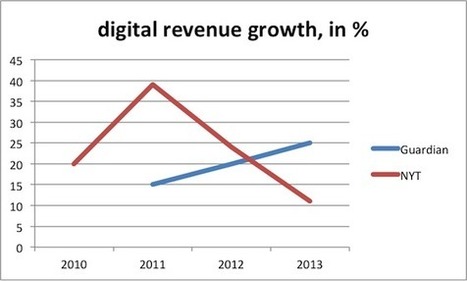





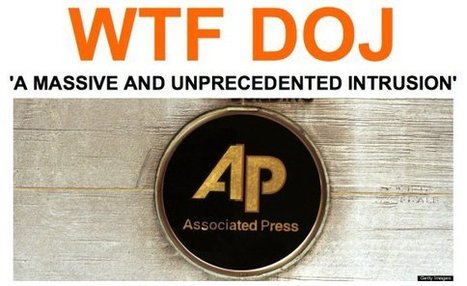


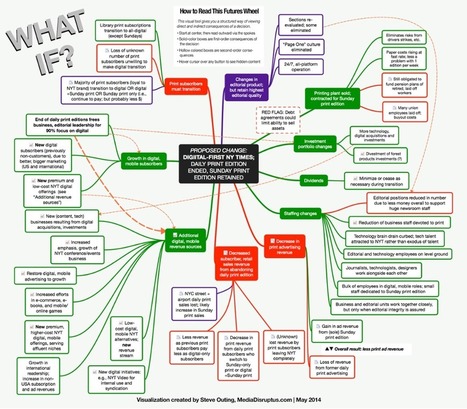


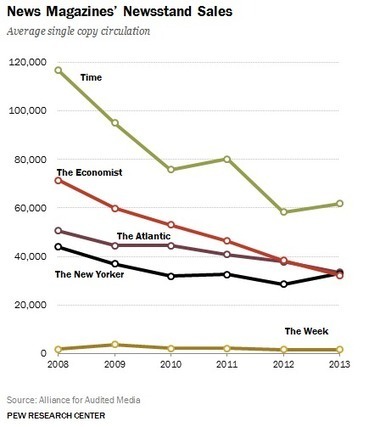




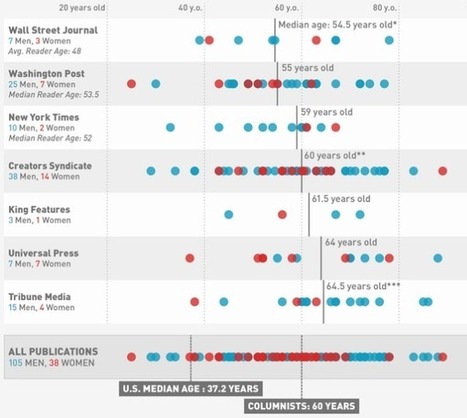



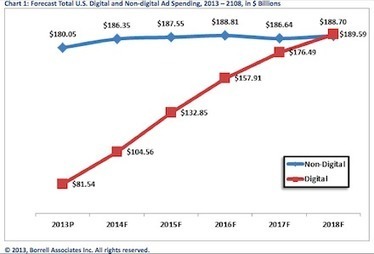






Any wonder why trust in journalism is at an all time low?